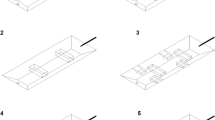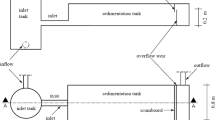Abstract
Control of rainfall-runoff particulate matter (PM) and PM-bound chemical loads is challenging; in part due to the wide gradation of PM complex geometries of many unit operations and variable flow rates. Such challenges and the expense associated with resolving such challenges have led to the relatively common examination of a spectrum of unit operations and processes. This study applies the principles of computational fluid dynamics (CFD) to predict the particle and pollutant clarification behavior of these systems subject to dilute multiphase flows, typical of rainfall-runoff, within computationally reasonable limits, to a scientifically acceptable degree of accuracy. The Navier-Stokes (NS) system of nonlinear partial differential equations for multiphase hydrodynamics and separation of entrained particles are solved numerically over the unit operation control volume with the boundary and initial conditions defined and then solved numerically until the desired convergence criteria are met. Flow rates examined are scaled based on sizing of common unit operations such as hydrodynamic separators (HS), wet basins, or filters, and are examined from 1 to 100 percent of the system maximum hydraulic operating flow rate. A standard turbulence model is used to resolve flow, and a discrete phase model (DPM) is utilized to examine the particle clarification response. CFD results closely follow physical model results across the entire range of flow rates. Post-processing the CFD predictions provides an in-depth insight into the mechanistic behavior of unit operations by means of three dimensional (3-D) hydraulic profiles and particle trajectories. Results demonstrate the role of scour in the rapid degradation of unit operations that are not maintained. Comparisons are provided between measured and CFD modeled results and a mass balance error is identified. CFD is arguably the most powerful tool available for our profession since continuous simulation modeling.
Similar content being viewed by others
References
Sansalone J J. Physical and chemical nature of stormwater pollutants. In: Field R, Sullivan D, eds. Wet Weather Flow in the Urban Watershed. Boca Raton: CRC Press, 2002, 43–66
Andoh RY G, Saul A J. The use of hydrodynamic vortex separators and screening systems to improve water quality. Water Science and Technology, 2003, 47(4): 175–183
USEPA. Stormwater technology fact sheet - Hydrodynamic Vortex Separators. EPA 832-99-017. 1999
Kim J Y, Sansalone J J. Event-based size distributions of particulate matter transported during urban rainfall-runoff events. Water Science and Technology, 2008, 42(10–11): 2756–2768
Sansalone J J. Adsorptive infiltration of metals in urban drainage-media characteristics. Science of the Total Environment, 1999, 235(1–3): 179–188
Geldof G, Jacobsen P, Fujita S. Urban storm water infiltration perspectives. Water Science and Technology, 1994, 29(1–2): 245–254
Wilson M A, Gulliver J S, Mohseni O, Hozalski R M. Assessing the effectiveness of proprietary stormwater treatment devices. In: Proceedings of World Environmental & Water Resources Conference, Tampa, FL, USA, 2007
Rossman L A. Stormwater Management Model Users Manual, Version 5.0, USEPA/600/R-05/040, Cincinnati, OH, USA, 2007
Huber W C, Dickinson R E. Storm Water Management Model User’s Manual, Version 4, EPA/600/3-88/001a (NTIS PB88-236641/AS). U.S. Environmental Protection Agency, Athens, GA, USA, 1988
Huber W C. BMP Modeling Concepts and Simulation. EPA/600/R-06/033, U.S. Environmental Protection Agency, Washington D C, USA, 2006
Weib G J. Vortex separator: proposal of a dimensioning method. Water Science and Technology, 1997, 36(8–9): 201–206
Paul T C, Sayal S K, Sakhuja V S, Dhillon G S. Vortex-settling basin design considerations. Journal of Hydraulic Engineering, 1991, 117(2): 172–189
Keblin V, Barrett M, Malina J, Charbeneau R. The effectiveness of permanent highway runoff controls: sedimentation/filtration systems. CRWR Online Report 97-4, University of Texas at Austin, 1997
Curtis J S, vanWachem B. Modeling particle-laden flows: a research outlook. American Institute of Chemical Engineers, 2004, 50(11): 2638–2645
Dickenson J A, Sansalone J J. Discrete phase model representation of particulate matter (PM) for simulating PM separation by hydrodynamic unit operations. Environmental Science & Technology, 2009, 43(21): 8220–8226
Pathapati S S, Sansalone J J. Can a stepwise steady flow computational fluid dynamics model reproduce unsteady particulate matter separation for common unit operations? Environmental Science & Technology, 2011, 45(13): 5605–5613
Stovin V R, Saul A J. Efficiency prediction for storage chambers using computational fluid dynamics. Water Science and Technology, 1996, 33(9): 163–170
Stovin V R, Saul A J. A computational fluid dynamics (CFD) particle tracking approach to efficiency prediction. Water Science and Technology, 1998, 37(1): 285–293
Naser G, Karney B W, Salehi A A. Two-dimensional simulation model of sediment removal and flow in rectangular sedimentation basin. Journal of Environmental Engineering, 2005, 131(12):1740–1749
Jayanti S, Narayanan S. Computational study of particle-eddy interaction in sedimentation tanks. Journal of Environmental Engineering, 2004, 130(1): 37–49
Faram M G, Harwood R. A method for the numerical assessment of sediment interceptors. In: Proceedings of 3rd international Conference on Sewer Processes and Networks, Paris, France, 2002
Tyack J N, Fenner R A. Computational fluid dynamics modeling of velocity profiles within a hydrodynamic separator. Water Science and Technology, 1999, 39(9): 169–176
Guo Q, England G, Johnston C E. Development of certification guidelines for manufactured stormwater BMPs. ASCE/EWRI task committee on guidelines for certification of manufactured storm-water best management practices (BMPs). In: Proceedings of World Environmental and Water Resources Congress EWRI, 2008
Gulliver J S, Guo Q, Wu J S. Scaling relations for manufactured stormwater BMPs. ASCE/EWRI Task Committee on Guidelines for Certification of Manufactured Stormwater Best Management Practices (BMPs). In: Proceedings of World Environmental and Water Resources Congress, 2008
USEPA. Urban stormwater BMP performance monitoring. A Guidance Manual for Meeting the National Stormwater BMP Database Requirements, EPA-821-B-02-001, 2002
Annandale G W. Scour Technology. New York: McGraw-Hill Professional, 2005, 24–25
Pathapati S, Sansalone J. Application of CFD to Stormwater Clarification Systems. In: Proceedings of World Environmental and Water Resources Congress EWRI, 2007
Rushton B. Broadway outfall stormwater retrofit project (Phase II - Monitoring CDS unit and constructed pond). Draft Report to EPA and Southwest Florida Water Management District (SFWMD), 2006, 124
American Society for Testing and Materials (ASTM). Standard test method for determining sediment concentration in water samples. Annual Book of Standards, Designation: D 3977-97, Vol. 04.08, Philadelphia, 2000, 395–400
American Society for Testing and Materials (ASTM). Standard practice for dry preparation of soil samples for particle size analysis and determination of soil constants. Annual Book of Standards, Designation: D 421-85. Vol. 04.08, Philadelphia, 1993, 8–9
Finlayson-Pitts B J, Pitts J N. Chemistry of the Upper and Lower Atmosphere -Theory, Experiments and Applications. CA: Academic Press, 2000, 365–368
American Society for Testing and Materials (ASTM). Automated Pore Volume and Pore Size Distribution of Porous Substances by Mercury Porosimetry (ASTM Designation: BMP578-02). West Conshohocken, PA, USA, 2003
Kim J Y, Ma J, Pathapati S, Sansalone J. Continuous deflective separation of non-colloidal particulate matter in rainfall-runoff. In: Proceedings of the 3rd Annual North American Surface Water Quality Conference and Exposition, Forrester Communications. CA: Palm Desert, 2004
Sheng Y, Ying G, Sansalone J J. Differentiation of transport for particulate and dissolved water chemistry load indices in rainfallrunoff from urban source area watersheds. Journal of Hydrology (Amsterdam), 2008, 361(1–2): 144–158
Urbonas B R. Recommended parameters to report with BMP monitoring data. Water Research, 1995, 121(1): 23–34
Versteeg H, Malalasekera W. An Introduction to Computational Fluid Dynamics: The Finite Volume Method Approach. London: Prentice Hall, 1995
Nowakowski A F, Cullivan J C, Williams R A, Dyakowski T. Application of CFD to modeling of the flow in hydrocyclones. Is this a realizable options or still a research challenge? Minerals Engineering, 2004, 17(5): 661–669
Statie E C, Salcudean M E, Gartshore I S. The influence of hydrocyclone geometry on separation and fibre classification. Filtration and Separation, 2001, 38(6): 36–41
Petty C A, Parks S M. Flow predictions within hydrocyclones. Filtration and Separation, 2001, 38(6): 28–34
Launder B E, Spalding D B. The numerical computation of turbulent flows. Computer Method in Applied Mechanics, 1974, 3(2): 269–289
Elghobashi S E. Particle laden turbulent flows: direct simulation and closure models. Applied Scientific Research, 1991, 48(3–4): 301–314
Morsi S A, Alexander A J. An investigation of particle trajectories in two-phase flow systems. Journal of Fluid Mechanics, 1972, 55(02): 193–208
Qi D, Lin W. TGrid: a new grid environment. In: Proceedings of First International Multi-Symposiums on Computer and Computational Sciences Conference (IMSCCS’06), 2006
Barth T J, Jespersen D. The design and application of upwind schemes on unstructured meshes. In: Proceedings of AIAA 27th Aerospace Sciences Meeting, 1989
Patankar S. Numerical Heat Transfer and Fluid Flow. Atlanta, USA: Hemisphere Publishing Corporation, 1980
Ranade V V. Computational Flow Modeling for Chemical Reactor Engineering. London: Academic Press, 2002
Author information
Authors and Affiliations
Corresponding author
Rights and permissions
About this article
Cite this article
Ying, G., Sansalone, J., Pathapati, S. et al. Stormwater treatment: examples of computational fluid dynamics modeling. Front. Environ. Sci. Eng. 6, 638–648 (2012). https://doi.org/10.1007/s11783-012-0442-7
Received:
Accepted:
Published:
Issue Date:
DOI: https://doi.org/10.1007/s11783-012-0442-7




